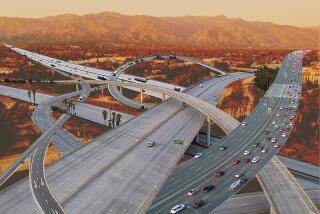City Smart / How to thrive in the urban environment of Southern California : Brain Is Far From Idle as You Cruise
- Share via
In the cult film “Repo Man,” a grease-smeared junkyard mechanic offers Emilio Estevez his take on life in Los Angeles: “The more you drive, the less intelligent you are.”
And while the observation may seem particularly apt as you lurch through the Cahuenga Pass, driving is not nearly as mindless as it sometimes seems.
The brain of the average driver is actually quite busy, processing thousands of bits of information every second and barking synaptic orders to the feet on the pedals, the hands on the wheel and even the butt in the seat. Barreling along at 55 m.p.h., the human body is constantly monitoring itself and making countless tiny corrections to do everything from keeping the car in the right lane to finding the quickest way home.
And most of this is going on without much conscious thought. Different parts of the brain have memorized things--like the location of the rearview mirror, the feel of the clutch and the play in the steering wheel--leaving other parts free to listen to Stephen Hawking’s new book on tape or to ponder the complexities of Fermat’s last theorem.
So in that way, figures USC neurobiologist and computer scientist Michael Arbib, driving actually can make you more intelligent. “The better you get at driving, the more intelligent you can be about other things by listening to ‘All Things Considered,’ for instance,” Arbib said.
*
Old elementary school films depict the brain as a sort of switchboard operator that coordinates the actions of the rest of the body. Although that is essentially correct, scientists now say a better way of looking at the brain is as a computer with several different processors responsible for different functions.
In the same way that you can play a quick game of computer solitaire as your spreadsheet calculates figures for the annual report, your brain can process information from the drive even as you listen to Howard Stern, talk on the car phone or anticipate the weekend.
“The brain is a parallel machine,” said Arthur Toga, a professor of neurology at UCLA Medical School. “We don’t do things one at a time, or evolutionarily we would die. In a hostile world we would never survive.”
When we are learning to drive, much of our brain is devoted to the task at hand. We learn through trial and error how much pressure to put on the gas pedal and how to manipulate the clutch in tandem with the gearshift. Once learned, though, the act of driving is stored in various parts of the brain and is done almost without awareness.
As we drive, our eyes scan the road ahead. This constant motion, called nystagmus, sends huge amounts of information to the visual cortex at the back of the head. That information is then cross-referenced through other parts of the cortex where memories are stored.
Most of what we see while driving is filtered out as irrelevant because our brain has learned over time to look just for those familiar landmarks that guide us wherever we are going. That is why driving on unfamiliar streets demands more attention than commuting to work.
*
Meanwhile, the hands are telling the brain their position on the wheel. The brain combines that with information from the eyes on whether the car is heading in a straight line and issues appropriate commands back to the hands. Likewise, the fluids in the inner ear, which regulate equilibrium, update the brain on whether you’re taking that curve too fast, depending on its angle and length.
All of this goes on more or less automatically in experienced drivers, and many of the motor skills required are run by the cerebellum at the back of the head--explaining why drivers sometimes look up and find themselves pulling into the driveway without remembering many of the turns along the way.
But when something out of the ordinary occurs, the brain shifts its resources.
When, for example, the eyes detect another car trying to merge into your lane, your response is automatic. The endocrine system is activated and the body is flooded with hormones that raise heart rate, sharpen vision and heighten awareness.
This, too, is the product of practice. The brain has learned that another car too close can be dangerous. “You might not have that reaction if you had never been in a car before,” Toga said. “But you have learned that this is a dangerous situation. It’s the classic fight or flight reaction.”
Pretty smart. “Repo Man” was wrong.






